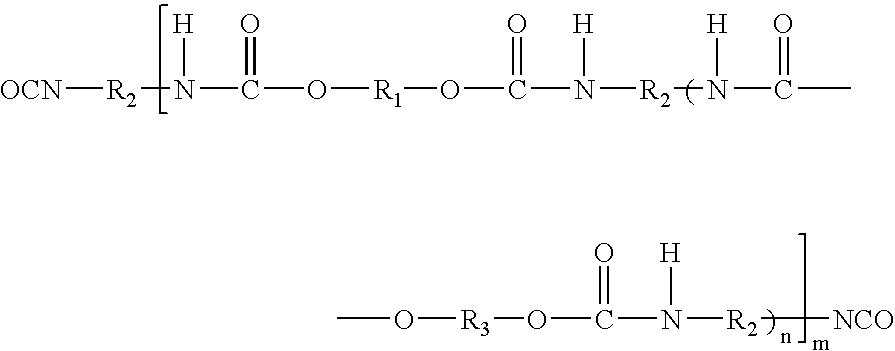Polyurethane dispersions for use in personal care products
a technology of polyurethane and personal care products, applied in the direction of hair cosmetics, pharmaceutical delivery mechanisms, powder delivery, etc., can solve the problems of significant aesthetic problems for consumers, lack of adhesion of hair, and detrimental to both the environment and the health of hair
- Summary
- Abstract
- Description
- Claims
- Application Information
AI Technical Summary
Benefits of technology
Problems solved by technology
Method used
Image
Examples
example 1
Composition According to the Invention
[0078]32.08 g of Desmophen® PE-170HN, polyesterdiol (M / wt. 1700, OH No. 66; adipic acid hexanediol neopentyl glycol ester) and 0.19 g of neopentyl glycol were reacted with 5.71 g of Desmodur® H (1,6-hexamethylene diisocyanate). When the reaction reached theoretical NCO %, the resulting prepolymer was cooled to 60° C. and dissolved in 60 g of acetone. After mixing for 30 minutes, a solution of 0.66 g of dipropylamine-diethyleneglycol (DPA-DEG from Tomah Products), 1.70 g of AAS (N-(2-aminoethyl)-2-aminoethane sulfonic acid) sodium salt, 0.16 g of ethylenediamine and 0.61 g of diethanolamine (DEOA) in 8.53 g distilled water was added dropwise. After mixing for 20 minutes, 58.14 g of distilled water at room temperature were added into reactor and the acetone was subsequently distilled off under reduced pressure. 0.52 g of biocide, Kathon® LX was added into the final product under agitation.
example 2
Composition According to the Invention
[0079]31.95 g of Desmophen® PE-170HN, polyesterdiol (M / wt. 1700, OH No. 66; adipic acid hexanediol neopentyl glycol ester) and 0.24 g of dimethylol butanoic acid (DMBA) were reacted with 5.69 g of Desmodur® H (1,6-hexamethylene diisocyanate). When the reaction reached theoretical NCO %, the resulting prepolymer was cooled to 60° C. and dissolved in 60 g of acetone. After mixing for 20 minutes, 0.17 g of AMP-95 (95% aq. solution of 2-amino-2-methyl-1-propanol) was added to the mixture to neutralize the acid. A solution of 1.31 g of dipropylamine-diethyleneglycol (DPA-DEG from Tomah Products), 1.05 g of AAS sodium (N-(2-aminoethyl)-2-aminoethane sulfonic acid) salt and 0.93 g of diethanolamine (DEOA) in 8.53 g distilled water was added dropwise. After mixing for 20 minutes, 58.14 g of distilled water at room temperature were added into reactor and the acetone was subsequently distilled off under reduced pressure. 0.52 g of biocide, Microcare® MTG ...
example 3
Comparative Example
[0080]32.22 g of Desmophen® PE-170HN, polyesterdiol (M / wt. 1700, OH No. 66; adipic acid hexanediol neopentyl glycol ester) were reacted with 5.74 g of Desmodur® H (1,6-hexamethylene diisocyanate). When the reaction reached theoretical NCO %, the resulting prepolymer was cooled to 60° C. and dissolved in 60 g of acetone. After mixing for 30 minutes, a solution of 1.52 g of AAS (N-(2-aminoethyl)-2-aminoethane sulfonic acid) sodium salt and 0.33 g of ethylenediamine in 8.53 g distilled water was added dropwise. After mixing for 20 minutes, 60.22 g of distilled water at room temperature were added into reactor and the acetone was subsequently distilled off reduced pressure. 0.52 g of biocide, Kathon® LX was added into the final product.
PUM
| Property | Measurement | Unit |
|---|---|---|
| Mn | aaaaa | aaaaa |
| Mn | aaaaa | aaaaa |
| Mn | aaaaa | aaaaa |
Abstract
Description
Claims
Application Information
 Login to View More
Login to View More - R&D
- Intellectual Property
- Life Sciences
- Materials
- Tech Scout
- Unparalleled Data Quality
- Higher Quality Content
- 60% Fewer Hallucinations
Browse by: Latest US Patents, China's latest patents, Technical Efficacy Thesaurus, Application Domain, Technology Topic, Popular Technical Reports.
© 2025 PatSnap. All rights reserved.Legal|Privacy policy|Modern Slavery Act Transparency Statement|Sitemap|About US| Contact US: help@patsnap.com



